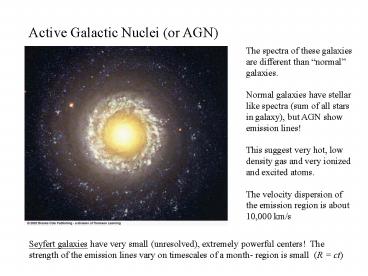Active Galactic Nuclei (or AGN) PowerPoint PPT Presentation
1 / 15
Title: Active Galactic Nuclei (or AGN)
1
Active Galactic Nuclei (or AGN)
The spectra of these galaxies are different than
normal galaxies. Normal galaxies have stellar
like spectra (sum of all stars in galaxy), but
AGN show emission lines! This suggest very hot,
low density gas and very ionized and excited
atoms. The velocity dispersion of the emission
region is about 10,000 km/s
Seyfert galaxies have very small (unresolved),
extremely powerful centers! The strength of the
emission lines vary on timescales of a month-
region is small (R ct)
2
NGC 4151 Seyfert w/ a Black Hole
We think all Seyfert galaxies have black holes in
their nuclei. Why? The Doppler effect strikes
again!
In this image, from the Hubble Space Telescope
Imaging Spectrograph, we see that some of the gas
is coming toward us and some is moving
away. This suggests rotation- very rapid
rotation in a small region of space. The only
object this dense and massive can be a black hole.
3
Even normal looking galaxies can have powerful
black holes.
M87, the central giant elliptical of the Virgo
Cluster of galaxies, has a small accretion disk,
out which arise a jet of material. The radio
image shows that it originates in a very small
region (1 light week in diameter).
4
NGC 4261
(left) An optical image shows a fairly normal
elliptical galaxy. A radio image overlay shows
powerful jets that pile up into double radio
lobes. In the center is an accretion disk
(right). The rotation axis is in the direction
of the jets.
5
Schematic of an accretion disk and its jets.
6
The fuel for a black hole is provided by
infalling stars and gas. Much of the mass of
each star does not fall into the black hole 99
of each star ends up contributing material to the
accretion disk and to the jets!
7
Channeled magnetic field lines carry the material
off in the jet.
8
Cygnus A
A classic example of a double radio lobe galaxy.
9
Evidence for the Intergalactic Medium
Note how the radio lobes of these jets appear to
be swept by the movement of the galaxy through a
medium
10
A computer model of 3C 129.
11
Quasars
Quasar is short for Quasi-stellar object. Note
how star-like this quasar appears compared to the
star.
12
If they are at the far reaches of the universe
and are very bright, then they must be extremely
luminous.
Quasars are highly redshifted, which places them
at great distances.
Recall Hubbles Law v H0 d
Velocity comes from the Doppler shift. But,
objects cannot move faster than the speed of
light so we need to use the Relativistic Formula
to convert distance, redshift, and velocity to
get it correct.
13
(No Transcript)
14
Gravitational Lens Remember Einstein and Light
Bending!
Since Quasars are so far away, there is a high
probability that massive material will lie
between us and the quasar. When this happens,
the light rays are bent (as shown below). Our
eyes project along two apparent light paths,
whereas the light from a single object has simply
been bent.
15
The Einstein Cross

